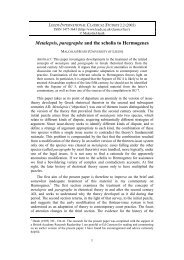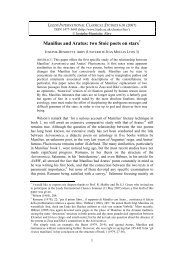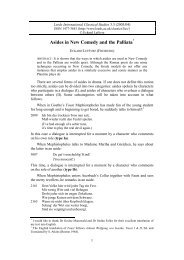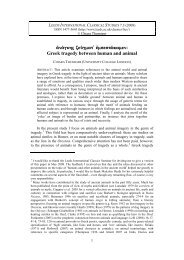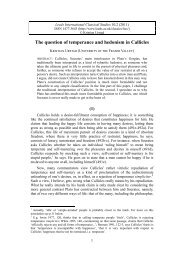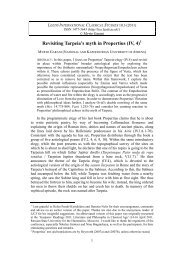The New Posidippus - Leeds International Classical Studies
The New Posidippus - Leeds International Classical Studies
The New Posidippus - Leeds International Classical Studies
Create successful ePaper yourself
Turn your PDF publications into a flip-book with our unique Google optimized e-Paper software.
MARY FRANCES WILLIAMS, THE NEW POSIDIPPUS<br />
mimesis. Aristotle is primarily interested in representational mimesis; 73 he uses the<br />
verb mimeisthai so that it has an aesthetic meaning (i.e., ‘likeness-making’) 74 as<br />
well as the meaning, ‘imitate artistic good practices’ (Poet. 15, 1454b9-10). He<br />
declares that art imitates nature (Phys. 2.2, 194a21-22), and also says that realistic<br />
portraiture is an important form of mimesis. 75 <strong>Posidippus</strong> places himself firmly<br />
within the Aristotelean tradition through his use of mimeisthai in relation to<br />
sculpture. 76<br />
When <strong>Posidippus</strong> encourages modern sculptors to ‘disregard the style of<br />
archaic artists’ (polucron…ouj... paraqe‹te nÒmouj Pos. X.8-9; 77 ¢rca‹ai...<br />
cšrej X.10; palaiotšcnhj X.11) and to ‘abandon the stylistic rules of those who<br />
predated the Canon of Polycleitus’ (Ð prÕ Poluke…to[u p£]gcu<br />
palaiotšcnhj X.11) in favor of ‘Lysippus’ new style’ (Lus…ppou ne£r' X.13;<br />
kainotecnšwn X.15; cf. XI.16-19), he expresses a major trend in late fourth- and<br />
third-century art. <strong>The</strong> sculptor Polycleitus (ca. 460-410) was one of the two most<br />
influential classical sculptors; he was famous for his sculpture of humans 78 and<br />
was the first artist to write a treatise on his art. Polycleitus’ Canon, a mathematical<br />
treatise on proportion that is ‘the first known professional criticism in sculpture’,<br />
was influential for more than a century. 79 Polycleitus emphasized proportionality<br />
of the body (symmetria) and absolute beauty. 80 <strong>The</strong> fourth-century Lysippus and<br />
his school were influenced by Polycleitus; 81 they advocated realism in portraiture<br />
and subjective vision, and they were influential throughout the Greek world. 82<br />
Pliny remarks:<br />
Lysippus is said to have contributed much to the art of sculpture, by rendering<br />
the hair in more detail, by making the heads of his figures smaller than the old<br />
sculptors used to do, and the bodies slenderer and leaner, to give his statues the<br />
appearance of great height. Latin has no word for the symmetria which he most<br />
scrupulously preserved by a new and hitherto untried system that modified the<br />
foursquare figures of the ancients; and he used to say publicly that while they<br />
had made men as they were, he made them as they appeared to be. A<br />
zwgr£foj ½ tij ¥lloj e„konopoiÒj (‘since the poet represents life, as a painter does or any other<br />
maker of likenesses’). Webster (1952) 22-3: in Poet. 25, 1460b8-11 Aristotle links poetry and art<br />
and introduces historical standards for both.<br />
73 Gallop (1999) 79. Arist. Poet. 4, 1448b5-12; Pol. 8.3, 1338a40-b2.<br />
74 Sörbom (1966) 177-9.<br />
75 Arist. Poet. 6, 1450b2-3; 15, 1454b9-18; Webster (1952) 14, 19.<br />
76 Halliwell (2002) 152-3: for Aristotle, the subject of mimeisthai can be a work, a genre, an artist,<br />
or a performer.<br />
77 Kosmetatou and Papalexandrou (2003) 53-6 argue that kolossoi means statues without regard to<br />
size. But <strong>Posidippus</strong>’ later poem on the Colossus of Rhodes indicates that he refers to huge statues<br />
(Pos. XI. 6-11 = 68 AB).<br />
78 Stewart (1990) I, 14, 21, 80, 160-2; Richter (1970) 189-95.<br />
79 Stewart (1990) 21, 80, 160-2; 261-5; T69 = Galen, De Placitis Hippocratis et Platonis 5.448;<br />
Stewart (1978b) 125. Pollitt (1974) 14-21; Richter (1970) 189-91.<br />
80 Stewart (1990) 21, 80, 160-2; 264-6; T68 = Galen, De Temperamentis i.566; Stewart (1978b)<br />
125. Pollitt (1974) 14-16. Plin. NH 34.55-6.<br />
81 Richter (1970) 190 & n.50; Cic. Brut. 296.<br />
82 Stewart (1990) I, 14-15, 289-94, 297-300. See Stewart (1978a) on the relationship between<br />
Lysippus’ Kairos and Polycleitus’ Canon.<br />
10



